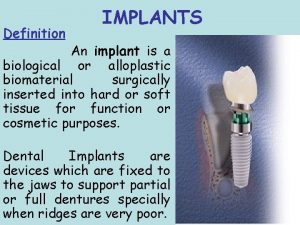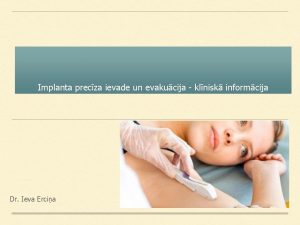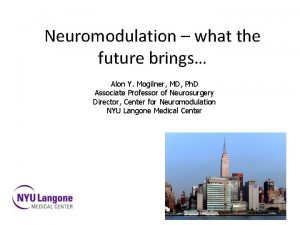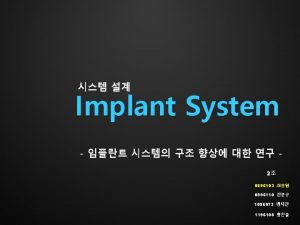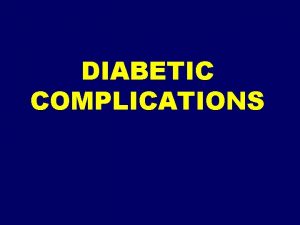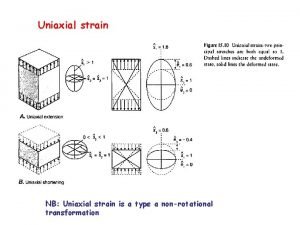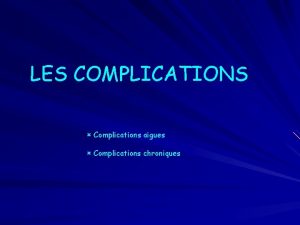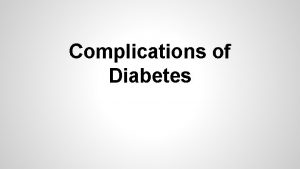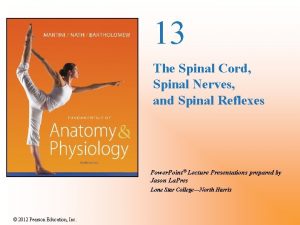ImplantRelated Complications Using Uniaxial Implants in Pediatric Spinal










- Slides: 10

Implant-Related Complications Using Uniaxial Implants in Pediatric Spinal Deformity Surgery 1 Department of Orthopaedic Surgery, The Hospital for Sick Children 2 Department of Physical Therapy, University of Toronto Masayoshi Machida, M. D 1 Brett Rocos, M. D 1 David E. Lebel, M. D, Ph. D 1 Karl Zabjek, BSc, MSc, Ph. D 2 Reinhard Zeller, M. D, FRCSC 1


Background and Objective • Deformity surgery is challenging and complex with implant related complication rates such as pullout and implant fracture [1 -3]. • To our knowledge there are no studies which investigated the clinical impact of implant-related complications on surgical outcomes using uniaxial implants, screws and hooks, in disease-specific cohorts. • Objective: • To evaluate the incidence of implant-related complications in pediatric spinal deformities treated with posterior spinal fusion using uniaxial implants.

Material and Method Study design: case series study Patients with pediatric spinal deformities that underwent PSF with uni-axial screws in our institution between 2006 and 2019. Inclusion criteria • Age < 18 years at the time of surgery Exclusion criteria • Patients treated other procedure (e. g. growing rod…)

Result: The all patients demographics Total (N=595) Idiopathic (N=449) Congenital (N=24) Neuromuscular (N=38) Syndromic (N=84) Age (years) 14. 5± 2. 4 14. 9± 1. 7 9. 1± 4. 6 13. 9± 2. 1 14. 2± 2. 6 Follow-up (years) 2. 4± 1. 5 2. 4± 1. 4 3. 6± 2. 1± 1. 8 2. 6± 1. 7 Average Number of rods 2. 1± 0. 3 2. 0± 0. 2 2. 1± 0. 3 2. 3± 0. 4 2. 2± 0. 4 Average number of uniaxial pedicle screws 15. 3± 4. 8 16. 2± 3. 7 5. 8± 1. 2 15. 3± 6. 5 13. 0± 5. 6 Average number of hooks 5. 4± 2. 9 4. 8± 2. 3 3. 7± 4. 4 7. 8± 3. 3 7. 6± 3. 5 Average number of clips 20. 7± 4. 1 21. 1± 2. 9 9. 7± 5. 4 23. 7± 4. 5 20. 6± 3. 9 Average number of transverse bars 2. 1± 0. 5 2. 1± 0. 3 1. 0± 1. 0 2. 5± 0. 5 2. 3± 0. 6 15 0 2 13 0 Cases of lumbosacral fusion

Result: All Implant failure cases Total (N=595) Implant failure Idiopathic (N=449) Congenital (N=24) Neuromuscular (N=38) Syndromic (N=84) 7 3 1 1 2 (1. 2%) (0. 7%) (4. 2%) (2. 6%) (2. 4%) 4 0 1 1 2 Revison cases (0. 7%) (0%) (4. 2%) (2. 6%) (2. 4%)

Result: Implant failures (f/u > 2 years): Non-union or isolated mechanical failure ? (Isolated mechanical failure = implant failure w/o loss of correction and solid fusion) All Complication cases Rod Breakage Uniaxial screws Loosening Breakage Iliac screws Loosening Breakage Hooks Complete slippage Partial slippage Clips Loss of fixation Breakage Transverse bars Dislocation Breakage Total (N=389) Idiopathic (N=294) Congenital (N=18) Neuromuscular (N=22) Syndromic (N=55) Revision cases Total Failure 1 0 Failure+ Non-union 1 1 0 0 0 1 0 1 1 0 0 1 1 1 0 0 0 0 1 7 (1. 8%) 3 (1. 0%) 1 (5. 6%) 1 (4. 5%) 2 (3. 6%) 0 1 5 (1. 3%) 3 (1. 0%) 1 (5. 6%) 1 (4. 5%) 0 (0%) 0 0 2 (0. 5%) 0 (0%) 2 (3. 6%) 0 0 4 (1. 0%) 0 (0%) 1 (5. 6%) 1 (4. 5%) 2 (3. 6%) 1

Discussion • The overall implant failure rate was 1. 2% (7/595). At a 2 years f/u 4 revision surgeries were performed (2 related to non-unions). • Uniaxial screws potentially decrease the level of stress at the bone-implant interface during the locking process while retaining the advantages of monoaxial screws with respect to better rotational control [4]. • The design of the uniaxial and polyaxial screws permit head angulation and allows the screw head to align with the rods and to adapt to the pre-bent rod, thus reducing rod reduction forces and enhancing rod resistance to slip compared to monoaxial screws, and significant increase in the axial slip strength [5].

Conclusion • The overall rate of implant-related complications was 1. 2 % with a revision rate of 0. 7%. • Implant failure due to non-union happened in 0. 5% of our patients. • This data is useful for the preoperative discussion about risks and benefits of a posterior spinal fusion in paediatric spinal deformities.

References 1) Clin J, Le Navéaux F, Driscoll M, et al. Biomechanical comparison of the load-sharing capacity of high and low implant density constructs with three types of pedicle screws for the instrumentation of adolescent idiopathic scoliosis. Spine Deform. 2019 Jan; 7(1): 2 -10. 2) Davis L Reames , Justin S Smith, Kai-Ming G Fu, et al. Complications in the Surgical Treatment of 19, 360 Cases of Pediatric Scoliosis: A Review of the Scoliosis Research Society Morbidity and Mortality Database. Spine (Phila Pa 1976). 2011 Aug 15; 36(18): 1484 -91 3) Al-Mohrej OA, Aldakhil SS, Al-Rabiah MA, et al. Surgical Treatment of Adolescent Idiopathic Scoliosis: Complications. Ann Med Surg (Lond). 2020 Feb 24; 52: 19 -23. 4) Essig DA, Miller CP, Xiao M, et al. Biomechanical comparison of endplate forces generated by uniaxial screws and monoaxial pedicle screws. Orthopedics 2012 Oct; 35(10): e 528 -32. 5) Serhan H, Hammerberg K, O'Neil M, et al. Intraoperative techniques to reduce the potential of set-screw loosening in long spinal constructs: a static and fatigue biomechanical investigation. J Spinal Disord Tech. 2010 Oct; 23(7): e 31 -6.







